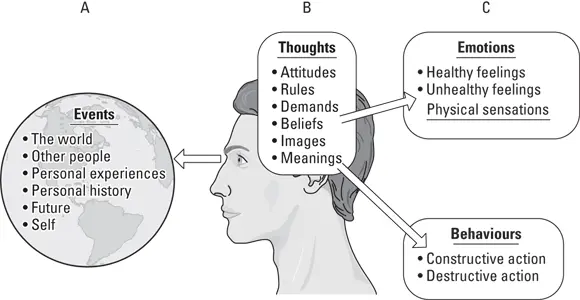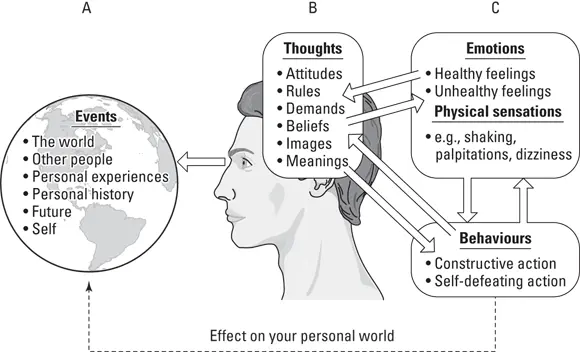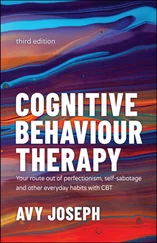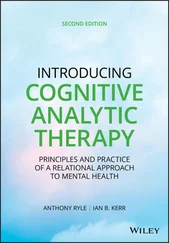When you start to get an understanding of your emotional difficulties, CBT encourages you to break down a specific problem you have using the ABC format, in which
A is the activating event . An activating event means a real external event that has occurred, a future event that you anticipate occurring or an internal event in your mind, such as an image, memory or dream. The A is often referred to as your ‘trigger’.
B is your beliefs. Your beliefs include your thoughts, your personal rules, the demands you make (on yourself, the world and other people) and the meanings that you attach to external and internal events.
C is the consequences . Consequences include your emotions, behaviours and physical sensations that accompany different emotions.
Figure 1-1 shows the ABC parts of a problem in picture form.

© John Wiley & Sons, Inc.
FIGURE 1-1: Ais the activating event, Bis your beliefs and thoughts and Cis the consequences, such as the emotions you feel after the event and your subsequent behaviour.
Writing down your problem in ABC form – a central CBT technique – helps you differentiate among your thoughts, feelings and behaviours and the trigger event. We give more information about the ABC form in Chapter 3, and you can find a blank ABC form in Appendix B.
Consider the ABC formulations of two common emotional problems, anxiety and depression. The ABC of anxiety may look like this:
A: You imagine failing a job interview.
B: You believe, ‘I’ve got to make sure that I don’t mess up this interview; otherwise, I’ll prove that I’m a failure’.
C: You experience anxiety (emotion), butterflies in your stomach (physical sensation), and drinking to calm your nerves (behaviour).
The ABC of depression may look like this:
A: You fail a job interview.
B: You believe, ‘I should’ve done better. This means that I’m a failure’!
C: You experience depression (emotion), loss of appetite (physical sensation), and staying in bed and avoiding the outside world and drinking to quell your depressed feelings (behaviour).
You can use these examples to guide you when you are filling in an ABC form on your own problems. Doing so will help ensure that you record the actual facts of the event under ‘A’, your thoughts about the event under ‘B’, and how you feel and act under ‘C’. Developing a really clear ABC of your problem can make it much easier for you to realise how your thoughts at ‘B’ lead to your emotional/behavioural responses at ‘C’. ( Chapter 3describes the ABC form more fully.)
We give a much fuller description of the principles and practical applications of CBT in the rest of this book. However, here’s a quick reference list of key characteristics of CBT. CBT
Emphasises the role of the personal meanings that you give to events in determining your emotional responses.
Was developed through extensive scientific evaluation.
Focuses more on how your problems are being maintained rather than on searching for a single root cause of the problem.
Offers practical advice and tools for overcoming common emotional problems (see Chapters 9, 12and 13Numbers may change).
Holds the view that you can change and develop by thinking things through and by trying out new ideas and strategies (head to Chapter 4).
Can address material from your past if doing so can help you to understand and change the way you’re thinking and acting now. ( Chapter 16covers this in depth.)
Shows you that some of the strategies you’re using to cope with your emotional problems are actually maintaining those problems. ( Chapter 7is all about this.)
Strives to normalise your emotions, physical sensations and thoughts rather than to persuade you that they’re clues to ‘hidden’ problems.
Recognises that you may develop emotional problems about your emotional problems – for example, feeling ashamed about being depressed. (See Chapter 6for more on this concept.)
Highlights learning techniques and maximises self-help so that ultimately you can become your own therapist (head to Chapter 22).
Sticking to the simple ABC formulation in which A + B = C can serve you well. But if that seems a little simplistic, you can consider the more complicated formulations shown here:

This diagram shows the complex interaction among your thoughts, feelings and behaviours. Although your thoughts affect how you feel, your feelings also affect your thinking. So, if you’re having depressed thoughts, your mood is likely to be low. The lower your mood, the more likely you are to act in a depressed manner and to think pessimistically. The combination of feeling depressed, thinking pessimistically and acting in a depressed manner can, ultimately, influence the way you see your personal world. You may focus on negative events in your life and the world in general and therefore accumulate more negative A s. This interaction among A, B and C can become a vicious circle.
CBT pays a lot of attention to changing both unhealthy thinking patterns and unhealthy patterns of behaviour.
Chapter 2
Spotting Errors in Your Thinking
IN THIS CHAPTER
 Identifying classic pitfalls in human thought
Identifying classic pitfalls in human thought
 Correcting your thinking
Correcting your thinking
 Getting to know the thinking errors you make most
Getting to know the thinking errors you make most
You probably don’t spend a lot of time mulling over the pros and cons of the way you think. Most people don’t – but to be frank, most people ideally ought to!
One of the central messages of CBT is that your thoughts, your attitudes and the beliefs you hold have a big effect on the way you interpret the world around you and on how you feel. So, if you’re feeling excessively bad, chances are that you’re thinking badly – or, at least, in an unhelpful way. Of course, you probably don’t intend to think in an unhelpful way, and no doubt you’re largely unaware that you do.
Thinking errors are slips in thinking that everyone makes from time to time. Just as a poor signal stops your phone from functioning effectively, so thinking errors prevent you from making accurate assessments of your experiences. Thinking errors lead you to get the wrong end of the stick, jump to conclusions and assume the worst. Thinking errors get in the way of, or cause you to distort, the facts. However, you do have the ability to step back and take another look at the way you’re thinking and set yourself straight. In this chapter we show you how to do just that.
 Months or years after the event, you’ve probably recalled a painful or embarrassing experience and been struck by how differently you feel about it at this later stage. Perhaps you can even laugh about the situation now. Why didn’t you laugh back then? Because of the way you were thinking at the time.
Months or years after the event, you’ve probably recalled a painful or embarrassing experience and been struck by how differently you feel about it at this later stage. Perhaps you can even laugh about the situation now. Why didn’t you laugh back then? Because of the way you were thinking at the time.
Читать дальше



 Identifying classic pitfalls in human thought
Identifying classic pitfalls in human thought Months or years after the event, you’ve probably recalled a painful or embarrassing experience and been struck by how differently you feel about it at this later stage. Perhaps you can even laugh about the situation now. Why didn’t you laugh back then? Because of the way you were thinking at the time.
Months or years after the event, you’ve probably recalled a painful or embarrassing experience and been struck by how differently you feel about it at this later stage. Perhaps you can even laugh about the situation now. Why didn’t you laugh back then? Because of the way you were thinking at the time.










